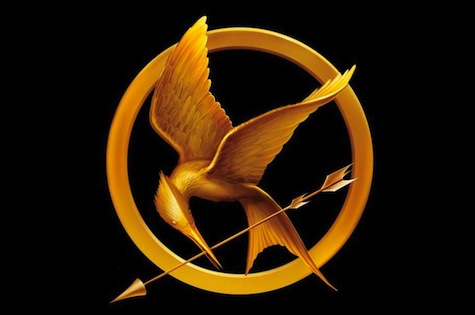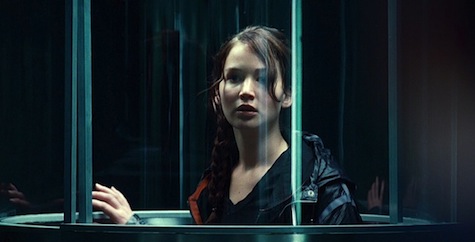
When I sat down to write about the Mockingjay symbol used in The Hunger Games trilogy, both the pin and Katniss Everdeen herself, the first thing I thought of was child soldiers and the Kony 2012 campaign.
Bear with me.
[Beware of spoilers from this point on, if you haven’t read the entire Hunger Games trilogy…]
One of the criticisms I’ve heard about the Kony 2012 campaign (criticism about Invisible Children, the organization that started it, aside) was that it was too slick: the video made too big an issue of finding Joseph Kony and oversimplified the many issues involved in the problem of child soldiers in Africa. Kony is not the only problem (or rather, he’s only part of the problem). This is very true.
Yet the Kony 2012 video went viral and spread in a way that years of news coverage, books, and the work of other organizations didn’t. It is precisely because Kony was used as a simple but potent idea and image that people were inspired to act in a way that simply appealing to their altruism and sense of decency just couldn’t. If a problem seems too large and complicated to solve, it becomes white noise.
In Panem, Katniss Everdeen focused the noise and broke through the static.
The Hunger Games trilogy presents an accurate portrayal of how propaganda can be used by either (or both) sides of a conflict to further their cause, as well as the importance of a charismatic spokesperson, or a human symbol, to a movement. It certainly isn’t the most important part. The most important part of any movement is the nuts and bolts organizing, the work on the ground, the thankless tasks that take way too long and are way too difficult. However, the importance of a galvanizing human symbol — either an enemy to hate, or a hero to support — cannot be underestimated. Smart organizing will plan for things like this. It is difficult for people to rally behind ideas, even good ones, because most people need to see how an idea will relate to them. But the right person as a symbol at the right time works as an example of someone to emulate, or puts a face to the abstract ideas and conditions to hate. Either way, it makes specific what was once abstract.
In real life, we saw this with Kony 2012. Portraying Joseph Kony as the archvillain, and having his capture be the obvious goal allowed people to become emotionally invested in a specific outcome. This caused people not only to spread the word, becoming active when they might otherwise have been passive, but inspired them to learn more about the surrounding issues, or at the very least introduced them to the surrounding issues as they insinuated themselves into this global conversation. Conversely the Occupy Movement, a leaderless one with an abstract enemy (“Wall Street,” “corporations,” “Big Business”), while it continues, has lost momentum and risks not being able to attract new support without a leader to rally behind, or a villain to punish.
In fiction, 1984’s Big Brother is a leader to follow and fear. What’s telling is that Oceania’s government (and George Orwell) was so aware of how important it is to put a face to an idea that it made one up. There was no actual Big Brother as a person, but the simple act of using a human face did more to control the population than Party coercion alone would’ve done. There’s something frightening about an individual, crazy/evil leader who would wield power that way. The machinations of a group behind the scenes is less threatening somehow — fewer people are scared of bureaucracy, though it’s actually how the real work of oppression gets done — and if the Party’s interest was in scaring people into inaction, then creating a leader like Big Brother made sense.

Even before Katniss, the mockingjay was already a symbol of rebellion in Panem. In the Dark Days, the Capitol genetically engineered jabberjays, all-male spying birds that were capable of memorizing conversations and bringing the information back, able to repeat it in a human voice. When the people of Panem started using them against the Capitol by feeding them lies, the Capitol abandoned the breed and left them in the wild to die. However, they began mating with female mockingbirds creating the mockingjay — a bird that should never have existed, that can imitate melodies perfectly, that emerged as a symbol of hope and survival.
And yet, the mockingjay alone, while a huge symbol, was not enough to inspire action toward change. At first, the Mockingjay was merely a passive symbol of hope; a way to muddle through; a consolation prize. When Madge Undersee gives Katniss a mockingjay pin, it’s as a symbol of solidarity across economic lines (she’s the District 12 Mayor’s daughter, Katniss is the daughter of a coal miner) in a thankless struggle. It’s what Katniss did with that image over the course of the three books that was important and elevated the mockingjay from passive to active symbol, and it is Katniss herself as the Mockingjay that inspired people.

What was great about Katniss, and the reason she was the perfect Mockingjay, was that she was reluctant about becoming a human symbol. She knew that the truly important work of rebellion was in the organizing and fighting, and she simply wanted to be part of that. She had no interest in being a poster girl. Yet, this is why she was the perfect choice of poster girl. A media-savvy public, like ours or the one in Panem, can smell insincerity a mile away. Or rather, we’re used to insincerity, and though we might not speak out against it, we know it when we see it, because it’s what we’re used to. It exists, but has lost its power to fool. Sincerity, on the other hand, pops. In an insincere world, the masses don’t know what to do with sincere, and so they listen more closely, curious. They see someone being different, and they pay attention.
As a tribute, Katniss resonated with people because of her unapologetic humanity. She was going to win for her sister. She genuinely cared about Rue. She genuinely cared about Peeta. She didn’t care about the superficial trappings of the Capitol. The viewing public could tell that, unlike the Career Tributes, Katniss was not an “act” devised for the pleasure of a viewing public. She was real. The fact that she also wore a mockingjay pin made it that much easier to make her a symbol. She was wearing one, so it made sense that she should become one.

By the final book of the trilogy, Mockingjay, Katniss willingly takes on the role of Media Darling, but only under the condition that all victors from the Hunger Games be granted immunity, and that she get to kill President Snow herself. She realizes that, despite her reservations and her natural tendency toward action, being a symbol is important work. Without that element, the people of Panem would not come together the way they did, and their coming together was imperative if they wanted to overthrow this tyrannical regime. Katniss continued to inspire on rebel news footage because of her genuine care for others, and her desire to kill President Snow herself, while fueled by her personal vendetta, was also a subconscious nod to the symbolism she’d taken on. One symbol killing another. The Hero killing The Villain. Katniss knew it had to be her to do it in order for the act to have real meaning.
Now, here’s where things get tricky. As we see in Mockingjay, the rebellion isn’t as simple as Good Vs. Evil, and it’s here that The Hunger Games trilogy succeeds as well, by accurately depicting the shades of grey. Both sides of a conflict can use or misuse their symbols, and Katniss Everdeen was used. President Coin, leader of the rebellion, might have started out with Panem’s best interests at heart, but her methods, like Gale’s, lost integrity along the way. Whereas Katniss’ intentions, motivations, and actions remained constant and unsullied by war, those around her fell into a savage survivor mentality. New world, new rules. By any means necessary. To Katniss, however, “any means” tarnishes the very thing they were fighting for: a Panem free of coercion and fear. So, rather than kill President Snow, she kills President Coin, which was another symbolic act. The Hero killing The True Villain.

President Coin was a symbol of how damaged and corrupted anyone can become if they allow their objectives to blind them to humanity. Katniss became a symbol of how there can be no true victory without humanity. Not as the Mockingjay to the citizens of Panem, but to us — the readers. What’s interesting is that the mockingjay pin in the books does not have an arrow, the way it does on the book’s covers and merchandise. It is described this way: “It’s as if someone fashioned a small golden bird and then attached a ring around it. The bird is connected to the ring only by its wing tips.” Therefore, the image of the Mockingjay that we see isn’t Panem’s original mockingjay symbol at all, it’s a symbol of Katniss, holding her weapon of choice. And when Katniss Everdeen shrugs off her role as the Mockingjay in the book and acts according to her conscience, she becomes symbolic of the best in humanity to us.
From now on, I’m calling my mockingjay pin my Katniss Pin.
Teresa Jusino wishes she were half the person Katniss Everdeen is. She can be heard on the popular Doctor Who podcast, 2 Minute Time Lord, participating in a roundtable on Series 6.1, and at the end of last year she was selected as one of the Top 11 Geek Girls of 2011 at the Geek To Me blog at Chicago Redeye. Her “feminist brown person” take on pop culture has been featured on websites like ChinaShopMag.com, PinkRaygun.com, Newsarama, and PopMatters.com. Her fiction has appeared in the sci-fi literary magazine, Crossed Genres; she is the editor of Beginning of Line, the Caprica fan fiction site; and her essay “Why Joss is More Important Than His ‘Verse” is included in Whedonistas: A Celebration of the Worlds of Joss Whedon By the Women Who Love Them, which is on sale now wherever books are sold! 2012 will see Teresa’s work in an upcoming non-fiction sci-fi anthology. Get Twitterpated with Teresa, “like” her on Facebook, or visit her at The Teresa Jusino Experience.










